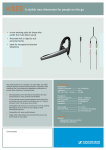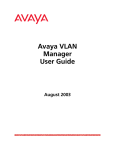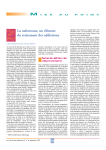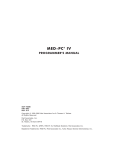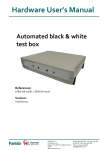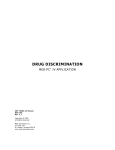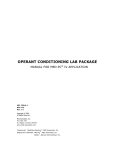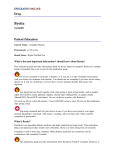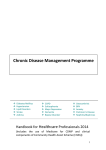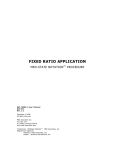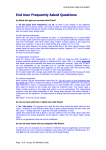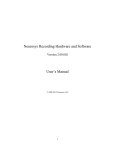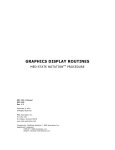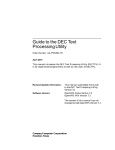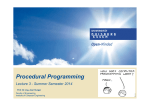Download INTRACRANIAL SELF-STIMULATION
Transcript
INTRACRANIAL SELF-STIMULATION MED-STATE NOTATION T M PROCEDURE DOC-128 Rev. 1.1 Copyright © 2008 All Rights Reserved Med Associates, Inc. P.O. Box 319 St. Albans, Vermont 05478 www.med-associates.com MED ASSOCIATES INC. ICSS PROCEDURES - ii - MED ASSOCIATES INC. ICSS PROCEDURES TABLE OF CONTENTS Chapter 1 .............................................................................................. 1 Introduction ...................................................................................................... 1 Overview of the Procedures .............................................................................. 2 Independent Variables ..................................................................................... 3 References ..................................................................................................... 3 Chapter 2 .............................................................................................. 4 Getting Started .................................................................................................. 4 Software Installation ....................................................................................... 4 Backing Up the Software .................................................................................. 4 Chapter 3 .............................................................................................. 5 Beginning & Running an Experiment ..................................................................... 5 Translating The MED-PC IV (.mpc) File............................................................... 5 Using the MED-PC IV Load Wizard ..................................................................... 6 Viewing/Changing Variable Values ..................................................................... 9 Macros ........................................................................................................ 11 Modifying the MedState Notation Code ............................................................. 12 Chapter 4 ............................................................................................ 12 Understanding the MED State Notation TM Procedures............................................. 12 Chapter 5 ............................................................................................ 17 Understanding the Data Files ............................................................................. 17 Sample Data File ........................................................................................... 17 - iii - MED ASSOCIATES INC. ICSS PROCEDURES - iv - MED ASSOCIATES INC. ICSS PROCEDURES CHAPTER 1 Introduction The purpose of this manual is to give an explanation of the MED State Notation™ Procedures that comprise the SOF-700RA-5 Intracranial Self Stimulation (ICSS) Procedures. The files in this package can be found on the disk provided by MED Associates, Inc. These procedures are intended to be run in MED Associates MED-PC ® IV software. The latest version of MED-PC ® IV gives researchers the ability to use pre-programmed procedures such as these to make hardware control and data collection easy. These preprogrammed procedures can also be modified to meet the evolving demands of a research protocol. Again, it is the intent of this manual to explain exactly what these procedures implement, and provide guidance into how to interpret what the program code achieves in order to let the user determine how to modify them to match their research protocol demands. The manual provides some examples of editing and modifying the procedure’s programming code. The manual also defines the elements in the raw data file produced by these procedures. In addition to this manual, refer to the MED-PC ® IV User’s Manual for the installation of the MED-Associates interface drivers, the MED-PC IV Software, and the Delphi ® Compiler. Also refer to the User’s Manual for instructions on developing a Hardware Configuration. Data file structure, file-saving format, and other related options are also determined by the Hardware Configuration. Running the Hardware Configuration software utility that accompanies MED-PC IV sets the Hardware Configuration. Its purpose is to assign the inputs and outputs on the interface cards in the interface cabinet for each task controlled by MED-PC IV. The particular type of interface card that is supplied in the interface cabinet may vary; please refer to the User’s Manual provided for instructions on how to configure the type of card that is in the cabinet. A valid Hardware Configuration must exist in order for MED-PC IV to interface correctly with the MED Associates, Inc. hardware. This means that one should take the time to create a valid Hardware Configuration before attempting to run the procedures included in this package. Should there be any problems, the staff at MED Associates, Inc. is available to answer any questions that may arise. Please e-mail us at [email protected] with a detailed description of the problem or desired goals so that concise and detailed information may be provided. The ICSS procedures are designed to be as easy to use as possible. MED Associates, Inc. understands that researchers do not have the time to devote to programming and hardware design, and for that reason, we have undertaken that burden for you. We sincerely hope that you are satisfied with the products and services we provide, and look forward to meeting your future experimental needs as your research program evolves. - 1 - MED ASSOCIATES INC. ICSS PROCEDURES Overview of the Procedures SOF-700RA-5 is a package of two MEDState Notation TM (MSN) procedures written for the control of intracranial self-stimulation (ICSS) in threshold determination. MED Associates, Inc. strongly encourages the creation of a backup copy of the procedures found on the ICSS CD. Having copies of the original procedures is helpful in the case of computer failure, and will provide a default copy of the original procedures in case changes to the programming code are necessary to implement a different experimental protocol. Reward.mpc This procedure uses a Discrete Trial Method developed by Dr. Conan Kornetsky, Boston University School of Medicine, in which the amplitude of both a free stimulus and a response contingent stimulus (reward) are the same. It is used while testing a trained subject. The program starts off with a free stimulation. If the animal likes the stimulation and responds, then it receives the same stimulation again as a reward. The program provides the same stimulation for five trials and then the trial block ends. At the end of the trial block the program checks how many times the animal responded and received a reward stimulation. In Descending trial blocks the program is looking to see how many times the animal did not respond (i.e. the animal could not feel the stimulation). If the animal does not respond three out of five times for two consecutive trial blocks, then the program has found the lower limit and switches to Ascending trial blocks. In Ascending trial blocks the program is looking to see how many times the animal did respond to the stimulation (i.e. the animal could feel the stimulation). If the animal does respond three out of five times for two consecutive trial blocks, then the program has found the upper limit and switches to Descending trial blocks. Between trial blocks the program decrements or increments the stimulation amplitude, depending on the trial type, by the Step Size. By default the program starts with Descending trial blocks so the User should select a starting amplitude that is between the expected lower and upper stimulation values. It is better to guess low than to guess high. For example if the User selects a starting amplitude that is too high and the animal receives a stimulation that it does not like, then it will not respond. The program will see that the animal is not responding and assume that it has found the lower limit and switch to an Ascending trial block. The problem is that the animal is not responding because he doesn’t like the stimulation, not because he can’t feel it. The program switching to Ascending trial blocks and increasing the amplitude will only make the problem worse. The program will end after four reversals (i.e. A change from a Descending trial block to a Ascending trial block or a change from a Ascending trial block to a Descending trial block). - 2 - MED ASSOCIATES INC. ICSS PROCEDURES Detection.mpc This procedure is a variation on the reward procedure in which the reward stimulus remains constant and only the free stimulus changes while testing thresholds. This procedure is used in training a test subject. It also determines the minimum stimulation amplitude necessary to produce a response by the test subject. Independent Variables Independent Variable Description Range Default Value Step Size The amount that the current will be increased or decreased (in uA) during testing. - 10 uA Pulse Width #1 The width of Pulse 1 in microseconds 60 – 32,000 us 200 us Pulse Amplitude #1 The amplitude of Pulse 1 in microamps 1 – 1,000 uA 80 uA Pulse Delay The delay between Pulse 1 and Pulse 2 in microseconds 60 – 32,000 us 100 us Pulse Width #2 The width of Pulse 2 in microseconds 60 – 32,000 us 200 us Pulse Amplitude #2 The amplitude of Pulse 2 in microamps 1 – 1,000 uA 80 uA Frequency Frequency in hertz 1 – 2,000 Hz 100 Hz Pulse Train Duration Duration of the stimulation in milliseconds - 500 ms Pulse Amplitude #2 for S2 This variable used in Detection.mpc program only. This is the reward stimulus duration. The value remains constant during testing. Only Pulse Amplitude #1 and Pulse Amplitude #2 will change during testing. - 80 uA References Kornetsky, Conan and Bain, George (1990). Brain-Stimulation Reward: A Model for DrugInduced Euphoria, Modern Methods in Pharmacology, Volume 6, Testing and Evaluation of Drugs of Abuse , Wiley-Liss, Inc., pp. 211-231. Bird, Michael and Kornetsky, Conan (1990). Dissociation of the Attentional and Motivational Effects of Pimozide on the Threshold for Rewarding Brain Stimulation, Neuropsychopharmacology , Volume 3, pp. 33-40. - 3 - MED ASSOCIATES INC. ICSS PROCEDURES CHAPTER 2 Getting Started Software Installation Please refer to the MED-PC IV User’s Manual for a complete guide to installing the MED-PC IV software, building a valid Hardware configuration with the Hardware Configuration utility, and opening and compiling a MSN procedure in the Trans-IV utility. To install the ICSS Procedures, insert the CD into the CD-ROM drive and click Install the Intracranial Self Stimulation Software. The ICSS procedures are copied into the C:\MED-PC IV\MPC folder. Backing Up the Software Med Associates strongly encourages creating backup copies of the programs in case of disk failure. Having copies of the original programs may be useful in the future should modifications be made to the existing programs. - 4 - MED ASSOCIATES INC. ICSS PROCEDURES CHAPTER 3 Beginning & Running an Experiment Translating The MED-PC IV (.mpc) File Programs written in MedState Notation must be translated using Trans IV before they can be executed in this application. Be sure that a copy of the file being translated is present in the directory “C:\MED-PC IV\MPC\.” Open Trans IV icon and select Translation | Translate and Compile. Select the program(s) to use for the experiment and click Make. Click OK to start the translator, and it will automatically parse the MedState Notation and then open to a DOS screen to compile the Pascal code. Depending on the speed of the computer, each of these steps may not be seen. If any problems are encountered during this process, refer to the on-screen help menu or the MED-PC Version IV User’s Manual, or contact MED Associates, Inc. for assistance. Figure 3.1 - Trans IV Control Panel for Translating and Compiling MedState Notation Code - 5 - MED ASSOCIATES INC. ICSS PROCEDURES Using the MED-PC IV Load Wizard MED-PC IV is designed to help the researcher run an experiment by guiding selection choices through its Experiment Loading Wizard. This section will describe how to initiate the Detection.mpc application, however the following steps that will also apply to all other .mpc procedures. Open MED-PC IV and the MED-PC Experiment Loading Wizard’s Welcome screen, shown in Figure 3.2 will appear. Figure 3.2 - The MED-PC IV Loading Wizard Welcome Screen To avoid this load wizard, deselect the checkbox labeled Run this experiment automatically when starting MED-PC. Close this screen by clicking the Close button. Closing this screen immediately reveals the MED-PC Run-Time Screen shown in Figure 3.9. If the choice to continue with the Loading Wizard is made, then click the Next button. - 6 - MED ASSOCIATES INC. ICSS PROCEDURES The Box Selection screen will appear next, as shown in Figure 3.3. From this screen the researcher chooses which boxes will be used in the experiment. Select the boxes that will run the experiment by clicking in the radio button next to the box number. The figure shows that the Hardware Configuration included only 1 box, which was selected. Click Next to continue. Figure 3.3 - The Box Selection Screen The Select a Procedure screen appears next, as seen in Figure 3.4. This is where the application to be run is selected. The screen displays a list of all the currently compiled procedures. Select the desired procedure and then click Next. Figure 3.4 - The Select a Procedure Screen - 7 - MED ASSOCIATES INC. ICSS PROCEDURES The Enter Experiment Data Screen should display next, as shown in Figure 3.5. The purpose of this screen is to allow annotations to be added to the data file that is produced by MED-PC IV. These annotations will help identify the Subject, Experiment, and Experiment Group upon which data was collected. Comments can be added here as well, and the data file can be given a customized file name to help identify it from other data files. Enter the information desired, and click Next. Figure 3.5 - Enter Experiment Data Screen The next screen to appear is the Review Choices screen, as seen in Figure 3.6. This is a method of confirming that the information received from the Box/Procedure Selected is correct. If it is not correct, select Previous, and edit the data. If it is correct, select Next. Figure 3.6 - Review Choices Screen - 6 - MED ASSOCIATES INC. ICSS PROCEDURES The Alter Session Parameters Screen, shown in Figure 3.7, is the next screen to appear, and is an important screen for the researcher. The Alter Session Parameters screen allows the researcher to alter the parameters by which a procedure executes. The Send Start Command Screen appears next. The options available on the screen vary depending upon how many boxes are described in the Hardware Configuration. Figure 3.7 - Alter Session Parameters Screen In this example only 1 box is described in the Hardware Configuration, so Figure 3.8 will appear next. If more than 1 box is in the Hardware Configuration, then Figure 3.9 will appear. Figure 3.8 - Send Start Command Screen for Single Box Configuration - 7 - MED ASSOCIATES INC. ICSS PROCEDURES Figure 3.9 - Send Start Command Screen for Multiple Box Configuration In both cases (Figure 3.8 and Figure 3.9), the screens are where the researcher decides to either load more boxes, send a start signal to boxes that are already loaded, or enter the MED-PC IV run-time environment without sending a start signal by selecting “I am finished with the wizard”. This option results in the screen shown in Figure 3.10. Figure 3.10 - The MED-PC IV Run-Time Screen - 8 - MED ASSOCIATES INC. ICSS PROCEDURES Viewing/Changing Variable Values Before a “start command” has been issued, any variable may be changed on the MED-PC IV run-time screen. Simply highlight the value to change, and then enter the new value. Once a session is in progress, change variables by selecting Configure | Change Variables, or click the 4th tool bar item ΔX. In the lower left hand corner of the Change Variables window, find the “Display Data from Box” display, and choose the chamber(s) to modify. By clicking additional boxes in the “Additional Boxes to Update” section, changes made to a single box are automatically loaded to all of the selected boxes. Figure 3.11 - Changing Variables Screen The value of any simple variable may be viewed from this screen by clicking an array on the table and each element in that array can be viewed, as shown in Figure 3.12. To change a value, simply highlight and replace the value in the lower right hand box or use the up/down arrows to increment by 1. Click the Issue button for the change to take effect. Click Named Variables to produce the display in Figure 3.13. Change variables here as needed. - 9 - MED ASSOCIATES INC. ICSS PROCEDURES Figure 3.12 - Displaying Array A from Box 1 Figure 3.13 - Displaying Named Variables from Box 1 - 10 - MED ASSOCIATES INC. ICSS PROCEDURES Macros The simplest way to initially create a macro is to record keyboard functions while performing the steps manually. Once the commands are in the macro, it is easy to create a number of macros with the macro editor. The following example illustrates the process of loading “Box 1” and changing the Step Size to 30. To begin, open MED-PC IV and going directly to the run time screen. Close the load wizard, if present. Before loading or opening the procedure, click Macro on the main menu and select Turn On Macro Recorder or click the 8th tool bar item with the cassette tape icon on top. A note on the bottom of the display indicates that the recorder is running. Open “Detection.mpc” by clicking Files | Open Session. Change the variables using any of the methods described above. When all settings have been made, turn the recorder off again by using the main menu or tool bar. Save the macro with a distinctive name. The example in Figure 3.14 was named “Detection_StepSize_30.mac” since the Step Size was changed to 30. Figure 3.14 – Detection_StepSize_30.mac Once this macro is built, use the macro editor to make simple changes such as replacing reward or correct lever values. Review the Help file on screen or the MED-PC IV User’s Manual for more information on macros and the features offered. A START command or message box followed by a START command could be added to the macro (it was left off here so changes could be verified before starting the procedure). - 11 - MED ASSOCIATES INC. ICSS PROCEDURES Modifying the MedState Notation Code Permanent changes to the ICSS procedures can be made to the MedState Notation code. To make the same change to the Step Size as shown above, do the following. Open Trans IV and select File | Open to place Detection.mpc into the text editor. Scroll down to approximately line 97 (note the line counter in the lower right hand corner of the editor) to reveal the code shown in Figure 3.15. Figure 3.15 – Detection_StepSize_30.mpc Line 97 On LIST P = change the 10 to a 30 and save the changes with the same or a new file name such as Detection_StepSize_30.mpc. Remember, if creating a new .mpc file name and are using a macro to load boxes, the file name in the macro also must be changed. Translate and compile the new or changed file as described previously and run MED-PC IV. Use the “Change Variables” screen to view/confirm the new values. - 12 - MED ASSOCIATES INC. ICSS PROCEDURES CHAPTER 4 Understanding the MED State Notation T M Procedures The Detection.mpc and Reward.mpc programs are so similar that only the State Sets in the Detection.mpc program are described in this chapter. \ Copyright (C) 2008 MED Associates, All rights reserved. \ Detection.mpc \ \ Detection Procedure - Discrete Trial Method - Method of Limits \ Based on procedures for Dr. Conan Kornetsky, Boston Univ., Sch. of Med. \ Inputs ^Wheel = 1 \ \ \ \ Chambers with Levers will have the LeftLever connected as Input 1. The constant ^Wheel may be changed to ^LeftLever here and throughout the procedure if desired. \ Outputs ^LeftStimLight ^RightStimLight ^Feeder ^SonAlert ^HouseLight = = = = = 1 2 3 4 5 \ \ \ \ The only output used in this procedure is the HouseLight. Output constants may be modified to match individual systems. \ P() = Control Variables with Assigned Aliases as Defined Var_Alias Step Size (uA) = P(0) \ Default = 10uA Var_Alias Pulse Width #1 (us) = P(2) \ Default = 200us Var_Alias Pulse Amplitude #1 (uA) = P(3) \ Default = 80uA Var_Alias Pulse Delay (us) = P(4) \ Default = 100us Var_Alias Pulse Width #2 (us) = P(5) \ Default = 200us Var_Alias Pulse Amplitude #2 (uA) = P(6) \ Default = 80uA Var_Alias Frequency (Hz) = P(7) \ Default = 100Hz Var_Alias Pulse Train Duration (ms) = P(8) \ Default = 500ms Var_Alias Pulse Amplitude #2 for S2 (uA) = P(9) \ Default = 80uA ^Step ^Node ^PWidth1 ^PAmp1 ^PDelay ^PWidth2 ^PAmp2 ^Freq ^Dur ^PAmpS2 = = = = = = = = = = 0 1 2 3 4 5 6 7 8 9 \ List Data Variables Here \ A() = Data Variables Used as Listed \ A(3) = # of Reversals \ A(11) = Total Cluster Responses \ A(12) = Total ITI Responses \ A(13) = Total Responses \ A(14) = Total Free Stimuli \ C() = Master Data Array. All data transferred to this array for Printing \ List Working Variables Here \ A() = Counter Variables Used as Listed \ A(0) = # of Non-Responses in Descending Column or Responses in \ Ascending Column in a 5 Trial Block (If A(0) >= 3 Increment A(2)) \ A(1) = # of Reward Stimulations in a 5 Trial Block \ A(2) = # of Consecutive 5 Trial Blocks in which Criteria is Met \ (If A(2) = 2, Procedure Changes from Ascending to Descending Trial \ Block and Vice-Versa) \ A(4) = Ascending/Descending Trial Block Tag \ A(4) = 0 if Descending \ A(4) = 1 if Ascending \ Program Starts with a Descending Trial Block \ A(5) = Trial Counter. If A(5) = 5 Record Data and set up for new Series \ A(6) = ITI Interval \ A(7) = Cluster Responses \ (1st. & all Subsequent Responses for First 2" of ITI.) \ A(8) = ITI Responses \ A(9) = Tag for Responses made During Free Stimulus. 1 = Response Made \ 0 = No Response Made \ A(10) = Block Counter. Each Block Contains 5 Trials \ A(16) = Value of Stim. Current for Data Printout. Gets set to \ the value of P(3) at Start of Procedure and after data \ is transferred to the C-Array \ A(17) = Value of Ascending/Descending trial block tag. Starts at \ zero by default and gets set to the value of A(4) after \ data is transferred to the C-Array - 12 - MED ASSOCIATES INC. \ \ \ \ \ \ \ B D() J P() ICSS PROCEDURES = = = = Response Latency counter (Resolution 0.01 sec.) Response Latencies for each Trial Block (Subscript A(5)) Subscript for the Master Data Array C (i.e., Set C(J) = A(4)) Stimulator Parameters LOW LIMIT DEFAULT: Set at 10 microamperes in S.S.1, S8. HIGH LIMIT DEFAULT: Set at 200 microamperes in S.S.1, S13. T() = List of Available ITI Intervals. Mean 15 seconds. DIM A = 20 DIM C = 500 DIM D = 10 LIST P = 10, 0, 200, 80, 100, 200, 80, 100, 500, 80 LIST T = 7.5", 9", 10.5", 12", 13.5", 15", 16.5", 18", 19.5", 21", 22.5" \ Z-Pulses Used in this Program \ Z1 = Signal Start of a Free Stimulus. \ Z2 = Signal Start of ITI Period. \ Z3 = Signal for no Response Made During 7.5" Following Free Stim. PRINTVARS = C PRINTOPTIONS = 80,FORMFEEDS PRINTFORMAT = 6.2 \*************************************************** \ Detection Schedule \ S1 - Set Default Values \ Step Size (10uA) \ Pulse Width #1 (200us) \ Pulse Amplitude #1 (80uA) \ Pulse Delay (100us) \ Pulse Width #2 (200us) \ Pulse Amplitude #2 (80uA) \ Frequency (100Hz) \ Pulse Train Duration (500ms) \ Pulse Amplitude #2 for S2 (80uA) \*************************************************** State Set 1 is the main portion of the program. It determines if this is an Ascending or Descending trial, and whether or not the criteria has been met to switch to the other trial type. It also contains the stimulation values and when to end the program. States 3 – 5 are used to set up the free stimulation at the beginning of a trial and determine if this is an Ascending or Descending trial. S.S.1, S1, \ Turn HouseLight ON when Procedure "STARTS" #START: CLEAR 1,60; ON ^HouseLight; SET P(^Node) = BOX, A(10) = 1, A(16) = P(^PAmp1) ---> S2 1": SHOW 1,Step Size,P(^Step), 2,Pulse Width 1,P(^PWidth1), 3,Pulse Amp 1,P(^PAmp1); SHOW 4,Pulse Delay,P(^PDelay), 5,Pulse Width 2,P(^PWidth2), 6,Pulse Amp 2,P(^PAmp2); SHOW 7,Frequency,P(^Freq), 8,Pulse Train Dur,P(^Dur), 9,S2...,P(^PAmpS2); SHOW 10,Node,BOX ---> SX S2, 0.1": ~Stimulate(MG, P[1], P[2], P[3], P[4], P[5], P[6], P[7], P[8]);~ ---> S3 S3, \ Free Stimulation Given at Start of Procedure 0.01": ~StimOn(MG, BOX, 1);~; ADD A(5), A(14); Z1 ---> S4 S4, \ Pause during Stimulation. Note: Duration of Stimulation \ is passed with Stimulate command parameter P[8] (P(^Dur)). \ Reset Stimulator parameters for S2 \ Test for a Response during Free Stimulation. 0.5": ~Stimulate(MG, P[1], P[2], P[9], P[4], P[5], P[9], P[7], P[8]);~; IF A(9) = 1 [@Response, @NoResponse] @Resp: ---> S5 @NoResponse: IF A(4) = 0 [@T, @F] @T: ---> S6 \ Descending Trial @F: ---> S11 \ Ascending Trial #R^Wheel: ADD A(7), A(11); SET A(9) = 1 ---> SX S5, \ If Response occurs during the Free Stim. Pause 0.5", Deliver \ a Reward Stimulation and Terminate the Trial. 0.5": ADD A(1); ~StimOn(MG, BOX, 1);~; Z2; IF A(4) = 0 [@T, @F] @T: ---> S9 \ Descending Trial @F: ADD A(0) ---> S14 \ Ascending Trial - 13 - MED ASSOCIATES INC. ICSS PROCEDURES States 6 – 9 are used to control the Descending Trials. At the end of each trial State 7 tests the following: • If the number of trials in the block have been completed (IF A(5) >= 5). • If the three trials with no response criteria has been met (IF (A(0) >= 3). • If the two consecutive blocks criteria has been met (IF A(2) >= 2). • If the four reversal criteria has been met (IF A(3) >= 4). State 8 tests the following: If the absolute lower limit for the amplitude has been reached (IF P(^PAmp1) <= 10). If it has, then an automatic reversal happens. • If the four reversal criteria has been met (IF A(3) >= 4). • The user may change any of these criteria by changing the appropriate IF statements in States 7 and 8. The same IF statements in States 12 and 13 must also be changed. Note: The number of trials in a block (IF A(5) >= 5) cannot be changed without also changing how the data is saved in the C Array. \---------------------------------------------------------------------------------------------------------------S6, \ Start of Descending Trial 7.5": ADD A(0); Z2; Z3 ---> S9 #R^Wheel: ADD A(1), A(7), A(11); ~StimOn(MG, BOX, 1);~; Z2 ---> S9 S7, 0.01": IF A(5) >= 5 [@EndTrialBlock, @ContTrialBlock] @EndTrialBlock: IF A(0) >= 3 [@CriteriaMet, @CriteriaNotMet] @CriteriaMet: SET A(0) = 0; ADD A(2); IF A(2) >= 2 [@TwoCriteriaMet, @TwoCriteriaNotMet] @TwoCriteriaMet: SET A(2) = 0; ADD A(3); IF A(3) >= 4 [@EndProcedure, @ContinueProcedure] @End: RANDD A(6) = T ---> S17 @Cont: RANDD A(6) = T; SET A(4) = 1 ---> S16 \ Change to Ascending Trial @TwoCriteriaNotMet: ---> S8 @CriteriaNotMet: SET A(0) = 0, A(2) = 0 ---> S8 @ContTrialBlock: RANDD A(6) = T ---> S15 \ Add Trial Count, set new ITI Value S8, \ Test Lower Limit and Decrease Current 0.01": IF P(^PAmp1) <= 10 [@LowerLimit, @Continue] @LowerLimit: ADD A(3); IF A(3) >= 4 [@EndProcedure, @ContinueProcedure] @End: RANDD A(6) = T ---> S17 @Cont: RANDD A(6) = T; SET A(4) = 1 ---> S16 \ Change to Ascending Trial @Continue: SET P(^PAmp1) = P(^PAmp1) - P(^Step); SET P(^PAmp2) = P(^PAmp2) - P(^Step); ~Stimulate(MG, P[1], P[2], P[3], P[4], P[5], P[6], P[7], P[8]);~; RANDD A(6) = T ---> S16 S9, \ Wait for S2 Pulse Train to End if Delivered \ Return to S1 parameters \ Continue Descending Trial 0.5": ~Stimulate(MG, P[1], P[2], P[3], P[4], P[5], P[6], P[7], P[8]);~ ---> S7 - 14 - MED ASSOCIATES INC. ICSS PROCEDURES States 11 – 14 are used to control the Ascending Trials. At the end of each trial State 12 tests the following: • If the number of trials in the block have been completed (IF A(5) >= 5). • If the three trials with no response criteria has been met (IF (A(0) >= 3). • If the two consecutive blocks criteria has been met (IF A(2) >= 2). • If the four reversal criteria has been met (IF A(3) >= 4). State 13 tests the following: If the absolute lower limit for the amplitude has been reached (IF P(^PAmp1) <= 200). If it has, then an automatic reversal happens. • If the four reversal criteria has been met (IF A(3) >= 4). • Any of these criteria may be changed by changing the appropriate IF statements in States 12 and 13. The same IF statements in States 7 and 8 must also be changed. Note: The number of trials in a block (IF A(5) >= 5) cannot be changed without also changing how the data is saved in the C Array. \---------------------------------------------------------------------------------------------------------------S11, \ Start of Ascending Trial 7.5": Z2; Z3 ---> S14 #R^Wheel: ADD A(0), A(1), A(7), A(11); ~StimOn(MG, BOX, 1);~; Z2 ---> S14 S12, 0.01": IF A(5) >= 5 [@EndTrialBlock, @ContTrialBlock] @EndTrialBlock: IF A(0) >= 3 [@CriteriaMet, @CriteriaNotMet] @CriteriaMet: SET A(0) = 0; ADD A(2); IF A(2) >= 2 [@TwoCriteriaMet, @TwoCriteriaNotMet] @TwoCriteriaMet: SET A(2) = 0; ADD A(3); IF A(3) >= 4 [@EndProcedure, @ContinueProcedure] @End: RANDD A(6) = T ---> S17 @Cont: RANDD A(6) = T; SET A(4) = 0 ---> S16 \ Change to Descending Trial @TwoCriteriaNotMet: ---> S13 @CriteriaNotMet: SET A(0) = 0, A(2) = 0 ---> S13 @ContTrialBlock: RANDD A(6) = T ---> S15 \ Add Trial Count, set new ITI Value S13, \ Test Upper Limit and Increase Current 0.01": IF P(^PAmp1) >= 200 [@UpperLimit, @Continue] @UpperLimit: ADD A(3); IF A(3) >= 4 [@EndProcedure, @ContinueProcedure] @End: RANDD A(6) = T ---> S17 @Cont: RANDD A(6) = T; SET A(4) = 0 ---> S16 \ Change to Descending Trial @Continue: SET P(^PAmp1) = P(^PAmp1) + P(^Step); SET P(^PAmp2) = P(^PAmp2) + P(^Step); ~Stimulate(MG, P[1], P[2], P[3], P[4], P[5], P[6], P[7], P[8]);~; RANDD A(6) = T ---> S16 S14, \ Wait for S2 Pulse Train to End if Delivered \ Return to S1 parameters \ Continue Ascending Trial 0.5": ~Stimulate(MG, P[1], P[2], P[3], P[4], P[5], P[6], P[7], P[8]);~ ---> S12 States 15 – 17 are used to time the Inter-Trial Interval and save the data from each trial. Responses during the ITI are punished by resetting the ITI. \---------------------------------------------------------------------------------------------------------------S15, \ ITI Interval for Trials 1-4 of Trial Block. #R^Wheel: ---> S15 \ Punish Responses in ITI by Resetting Timer A(6)#T: SET A(9) = 0 ---> S3 \ End ITI Interval S16, \ ITI Interval & Data Saving for End of Block of 5 Trials. #R^Wheel: ---> S16 \ Punish Responses in ITI by Resetting Timer A(6)#T: SET C(J) = A(17), C(J+1) = A(16), C(J+2) = A(1), C(J+3) = D(1); SET C(J+4) = D(2), C(J+5) = D(3), C(J+6) = D(4), C(J+7) = D(5); SET C(J+8) = A(7), C(J+9) = A(8), A(1) = 0, A(7) = 0, A(8) = 0; SET J = J + 10; IF J = 500 [@AbortProcedure, @StartNewTrialBlock] @Abort: PRINT ---> S20 @StartNew: SET C(J) = -987.987, A(5) = 0; SET A(16) = P(^PAmp1), A(17) = A(4); SET A(9) = 0; ADD A(10); ZEROARRAY D ---> S3 - 15 - MED ASSOCIATES INC. ICSS PROCEDURES S17, \ Save Data from last Trial Block and Generate Printout A(6)#T: SET C(J) = A(4), C(J+1) = A(16); SET C(J+2) = A(1), C(J+3) = D(1); SET C(J+4) = D(2), C(J+5) = D(3); SET C(J+6) = D(4), C(J+7) = D(5); SET C(J+8) = A(7), C(J+9) = A(8); SET C(J+10) = -987.987; PRINT ---> S20 S20, \ End Procedure 1": ---> STOPABORTFLUSH State Set 2 records the latency to the response during the trial. \*************************************************** \ RESPONSE LATENCY \*************************************************** S.S.2, \ Record Response Latency in Array D until End of 5 Trial Block S1, \ when transferred to Print Array. See S.S.1, S16 & S17. #Z1: ---> S2 \ Start "Clock" with Occurance of Free Stimulus S2, #R^Wheel: SET D(A(5)) = B, B = 0 ---> S1 #Z3: SET B = 0 ---> S1 \ No Response Made 0.01": SET B = B + 0.01 ---> SX State Set 3 counts the Cluster Responses and the number of Responses during the ITI. Cluster Responses is the first response that happens during the trial and all of the responses during the first 2 seconds of the ITI. \*************************************************** \ COUNT CLUSTER/ITI RESPONSES \*************************************************** S.S.3, \ Counters transferred to Print Array and Reset at End of S1, \ each 5 Trial Block. See S.S.1, S16. #Z2: ---> S2 S2, #R^Wheel: ADD A(7), A(11) ---> SX 2": ---> S3 \ Count Cluster Responses S3, #R^Wheel: ADD A(8), A(12) ---> SX #Z1: ---> S1 \ Count ITI Responses State Set 4 counts the total number of Responses. \*************************************************** \ COUNT TOTAL RESPONSES \*************************************************** S.S.4, S1, #START: ---> S2 S2, #R^Wheel: ADD A(13) ---> SX \ Count Total Responses State Set 5 updates the display with the most current information for the running trial. \*************************************************** \ DATA DISPLAY \*************************************************** S.S.5, S1, #START: ---> S2 S2, 0.5": SHOW SHOW SHOW SHOW 1,Column #,A(3)+1, 4,Stim Amplitude,A(16), 12,Cluster Resp,A(7), 15,Two Criteria Met,A(2) 2,D/A Tag,A(4), 5,Reward,A(1), 13,ITI Resp,A(8), ---> S3 3,Block #,A(10); 11,Resp Latency,D(A(5)); 14,Criteria Met,A(0); S3, 0.1": SHOW 21,Total Cluster Resp,A(11), 22,Total ITI Resp,A(12), 23,Total Resp,A(13); SHOW 24,Total Free Stimuli,A(14), 31,Trial #,A(5), 32,ITI Interval,A(6)/1"; SHOW 33,Resp Dur Free Stim,A(9) ---> S2 - 16 - MED ASSOCIATES INC. ICSS PROCEDURES CHAPTER 5 Understanding the Data Files Unless otherwise specified, data will be saved to C:\MED-PC IV\DATA. Data can be saved manually by selecting FILE | SAVE DATA MANUALLY or FILE | SAVE DATA (FLUSH). The file name that is used to save the data in depends on the option that was chosen in the Hardware Configuration Utility and may also be dependent on the Subject, Experiment, and Group name provided in the MED-PC IV load wizard. Within each data file, the headings are created for each Subject, Experiment, Group, Box, etc., (see below). Data files may be opened with note pad, word pad, or any word processor or spreadsheet; however, be sure they are always saved “unformatted” in case a data extraction utility such as MED-PC to Excel might ever be used. Data file formats are explained in detail in the MED-PC IV User’s Manual. Sample Data File Select Annotated on the file options page during hardware installation to produce a raw data file similar to the following. Data files are located in C:\MED-PC IV\Data\ unless an alternate path was defined during hardware installation. They may be opened with note pad, word pad, or any word processor; however, make sure they are always saved unformatted in the occasion a data extraction utility such as MPC2XL is used. The header information should be selfexplanatory. Data-file formats are explained in detail in the MED-PC IV User’s Manual. File: C:\MED-PC IV\DATA\!2006-12-06_09h09m.Subject 7 Start Date: 12/06/06 End Date: 12/06/06 Subject: 7 Experiment: 5 Group: 1 Box: 1 Start Time: 9:09:59 End Time: 9:36:59 MSN: Detection Session identification information that was entered during the load wizard. B: E: F: G: H: I: J: K: L: M: N: O: Q: R: S: U: V: W: X: Y: Z: B = Response Latency Counter J = Subscript for the Master Data Array C 0.000 0.000 0.000 0.000 0.000 0.000 130.000 0.000 0.000 0.000 0.000 0.000 0.000 0.000 0.000 0.000 0.000 0.000 0.000 0.000 0.000 - 17 - MED ASSOCIATES INC. ICSS PROCEDURES A: 0: 5: 10: 15: 20: 0.000 5.000 5.000 10500.000 14.000 73.000 0.000 80.000 0.000 0.000 10.000 15.000 1.000 4.000 2.000 88.000 0.000 1.000 0.000 70.000 0.000 C: Most of these values are used for the control/flow of the program. At the end of the program the values that still mean something are: A(3): Number of Reversals A(11): Total Cluster Resp A(12): Total ITI Resp A(13): Total Responses A(14): Total Free Stimuli The C Array contains the main data that is saved from the program. Data is saved in blocks of 10. Here is what the data means: 0: 5: 0.000 0.000 80.000 2.190 4.000 5.070 5.790 9.000 4.430 4.000 10: 15: 0.000 1.860 70.000 0.000 2.000 2.980 0.000 4.000 0.000 1.000 20: 25: 0.000 0.000 60.000 0.000 0.000 0.000 0.000 0.000 0.000 0.000 30: 35: 1.000 0.000 60.000 7.760 1.000 0.000 0.000 1.000 0.000 0.000 40: 45: 1.000 0.000 70.000 0.000 1.000 0.000 0.000 2.000 1.940 0.000 50: 55: 1.000 7.590 80.000 2.180 4.000 0.000 3.670 15.000 1.070 5.000 60: 65: 1.000 1.060 90.000 2.380 4.000 2.350 1.440 12.000 0.000 0.000 70: 75: 0.000 1.290 90.000 1.540 5.000 1.810 5.790 8.000 1.190 1.000 C(J+4): Response Latency for 2nd Trial 80: 85: 0.000 1.750 80.000 5.860 4.000 0.000 4.420 4.000 4.270 0.000 C(J+5): Response Latency for 3rd Trial 90: 95: 0.000 0.000 70.000 1.140 2.000 0.000 0.000 2.000 2.360 0.000 100: 105: 0.000 0.000 60.000 0.000 0.000 0.000 0.000 0.000 0.000 0.000 110: 115: 1.000 0.000 60.000 0.000 1.000 0.000 0.000 1.000 5.560 0.000 120: 125: 1.000 1.230 70.000 6.410 3.000 0.000 3.190 5.000 0.000 2.000 130: 135: 1.000 3.160 80.000 1.460 5.000 1.240 1.600 10.000 1.390 2.000 0.000 1.240 0.000 1.600 0.000 1.390 0.000 3.160 0.000 1.460 0.000 10.000 200.000 1.000 80.000 200.000 100.000 80.000 500.000 100.000 80.000 D: 0: 5: 10: P: 0: 5: - 18 - C(J): 0 = Descending Trial Block 1 = Ascending Trial Block C(J+1): Stim Amplitude Value this Trial Block C(J+2): # Reward Stims this Trial Block C(J+3): Response Latency for 1st Trial C(J+6): Response Latency for 4th Trial C(J+7): Response Latency for 5th Trial C(J+8): Number of Cluster Responses this Trial Block C(J+9): Number of ITI Responses this Trial Block The D Array is used to save the response latency for each trial (1 – 5). The values are saved to the C Array at the end of each Trial Block. The P Array contains the starting stimulation values. MED ASSOCIATES INC. ICSS PROCEDURES T: 0: 7500.000 9000.000 10500.000 12000.000 13500.000 5: 15000.000 16500.000 18000.000 19500.000 21000.000 10: 22500.000 - 19 - The T Array contains the ITI values that were used in the program. The values were converted to MED Ticks once the program was loaded.


























